
Why desert ruins should be on your travel list
What's the story
Desert ruins have a special charm for adventure travelers, providing an insight into ancient civilizations, and the secrets they left behind. These sites are all over the world, waiting for you to discover them. From expansive sand dunes to rocky terrains, these places are sure to give a thrilling experience to anyone willing to delve into their secrets. Be it history buff or an adventure seeker, these desert ruins guarantee an unforgettable journey!
Petra
Lost City of Petra: A hidden gem
Jordan's ancient city of Petra is famous for its rock-cut architecture and water conduit system. Once a bustling trading center, the site now serves as a reminder of the Nabataeans' ingenuity. One can walk through its narrow canyon entrance Al Siq and admire the Treasury and Monastery. The site provides a glimpse into ancient engineering and artistry that still fascinates explorers globally.
Chan Chan
Machu Picchu's desert counterpart: Chan Chan
Situated in Peru, Chan Chan was the largest city in pre-Columbian America. Constructed by the Chimu civilization, this adobe city covers an area of around 20 sq. km. Its complex layout with plazas, temples, and reservoirs speak of advanced urban planning skills. Although located near arid coastal deserts, it flourished with innovative irrigation techniques. A visit to this UNESCO World Heritage Site gives a peek into life before Inca supremacy.
Meroë
The enigmatic pyramids of Meroe
Located in Sudan's Nubian Desert is Meroe, the site of over 200 pyramids constructed by the Kingdom of Kush between 300 BCE and 350 CE. These smaller but unique pyramids were used as royal tombs, decorated with hieroglyphics showcasing scenes of daily life and mythology. Unlike their Egyptian cousins on the Nile River banks further northwardly located, these structures are still less crowded but equally mesmerizing for history buffs looking for off-the-beaten-path experiences.
Hampi
Mesmerizing ruins at Hampi's Vijayanagara Empire
Hampi, which was once part of India's Vijayanagara Empire, prospered as one of Asia's richest cities until 1565 when it declined. Today, temple remnants, palaces, markets, and aqueducts litter its terrain. These ruins, which have been a UNESCO World Heritage site since 1986, still pull tourists with their architectural and historical importance even as preservation efforts continue.